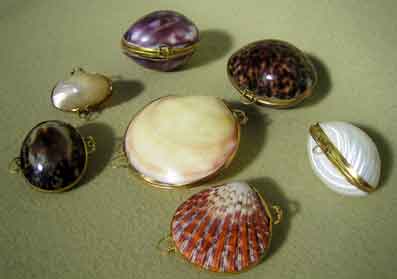| Archery |
| Brewing |
| Calligraphy & writing |
| Combat |
| Cooking |
| Dance |
| Etiquette |
| Household life |
| Medicine |
| Music |
| Needlework |
| Playacting |
| Religion |
| Storytelling |
| For safety information etc, see Toy Collection Information |
Price List |
|
|
Books
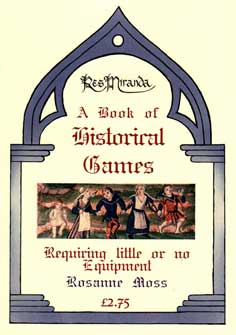 |
|
|
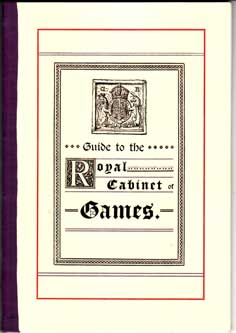 |
Cup and Ball
| The cup and ball may have come from Italy, though a similar game was known in ancient Greece. We know it became popular in the Tudor period and that it was enjoyed by the upper classes who had beautifully turned toys which were very expensive to buy. It was very popular in 18th century France and men and women are dpeicted playing it. Captain Cook found it being played in the Sandwich Islands in the 18th century. It was known in Mexico and among the American Indians. The version in which the ball can also be caught on a spike - that known as "Bilboquet" demands considerbale skill for the feat to be performed. |
Dice
| Games of dice are suitable for all periods and have probably been consistently favoured for games of chance and gambling throughout the ages. Early clay dice from c 1500 BC were found at Mehenjodaro. The true knucklebone has been used as a die, owing to its almost regular rectangular shape. These probably gave rise to the long four-sided die. Any reasonable hard material which can be shaped has been used to make dice. The cube-shaped dice ones we make are of hard-wood, randomly numbered as was usually the case in the middle ages and supplied in a set of three with some suggested games, including the ever popular game of "Hazard". |
Diabolo
| Diabolo came to England from China and was played at the French and English courts in the latter half of the 15th century. It was known as the "Flying Cone". THe game became very popular during the French revolution (from 1789) and was then known as "Thye Devil on two sticks". Fashionable ladies and gentlemen were playing it in 1796 and Napoleon enjoyed the game. In 1820, as "le Diable" the craze spread through Europe. |
Hobby-Horse
| Hobby horses have been around since at least 400 BC. Socrates's children played with one and they have enjoyed periods of popularity throughout the ages and all over the world. The simplest hobby horse of all is a stave of wood but horses's heads with reins or a cross bar are shown in many Medieval manuscripts. The use of wheels again seems to be a matter of choice. Each one of our hand-painted hobby horses is unique - you won't find another like it in the stable! |
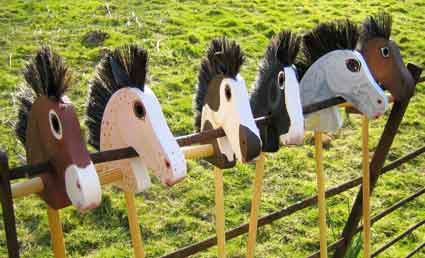
Hoop
| Hoops are ancient toys known to have been used by the Egytians and Greeks. They are another toy which is known throughout the world. We know they were popular in the middle ages. A 16th century Flemish calendar shows them for the month of February. Their use involves plenty of running so they were a good toy for the colder months. The hoops are 24 inches in diameter and are supplied with two sticks - one of dowel and one a natural, hazelwood stick. |
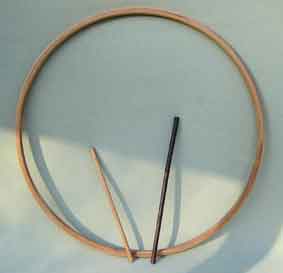
Knucklebones
| Knucklebones have been used for play since ancient times.We supply three sizes to suit children's hands together with an instruction sheet with suggested games. |
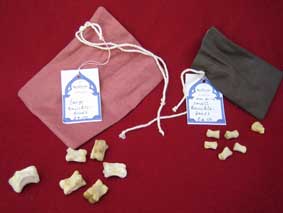
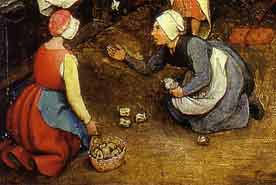
Leather Balls
| These leather balls come in three sizes. They are hand-stitched with edge-to-edge seams and stuffed with wool - loom ends from our friend, Roger Poulson's mill, "Curlew Weavers", unspun wool or chopped woolen cloth. They even bounce! To give you an idea of the size, Benet agreed to model with them - he's a large labrador. The smallest is smaller than a tennis ball and the largest more than a handful.The large size is excellent for group games involving throwing and catching. These remain available but please allow time for cutting, stirching and stuffing. |
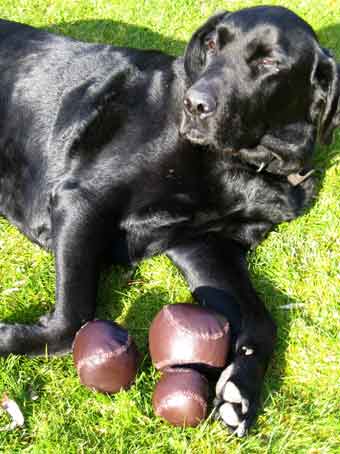
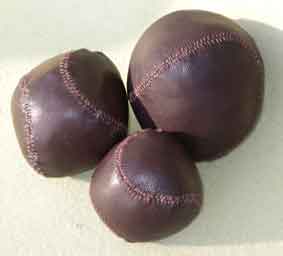
Marbles
| Marbles have been used in play from prehistoric times to the present day. They have been found in a fourth millenium BC child's grave at Nagada, Egypt; marbles of jasper and agate were made at Chanhudaro in 2500 BC. Round clay pellets have been found in England dating from 312 BC. Early marbles were of clay, or stone; oak galls or nuts could also be used. We have some stone marbles appropriate to all periods. Glass marbles were introduced in the early 19th century. 25p each. There are just a few left and, to date, we have been unable to find any more stone marbles. |
Playing Cards
| We have various sets of playing cards. The early set, with no tax mark, covers the period 1600-1760. This comes either as a fully printed set or, for a more authentic set, choose the de-luxe set with hand-coloured court cards. We can also supply a set with the tax mark of George III (1760-1820), price £11.25. |
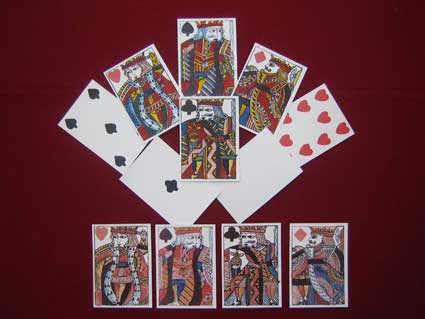
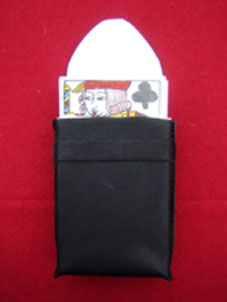 |
|
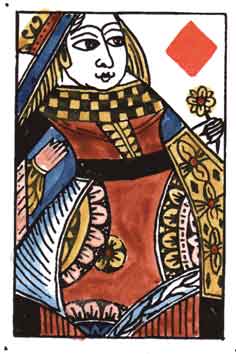 |
Skittles/Kayles
Skittles or ninepins have been known since the fourth millenium BC, the number nine being consistent throughout.Stone ninepins were found in the graves of Egyptian children c, 1500 BC, the Romans played the game in the time of Julius Caesar. The game seems to have arrived in Britain from Holland.. Medieval manuscripts depict boys playing, knocking down the pins with a ball but in the 14th century it was played by throwing a stick and known as "Club Keyles" or "Kayles". Elizabeth I and her ladies played with a set of ivory ninepins. |
Skipping Rope
| The skipping rope is of hemp and is large enough for an adult to use. |
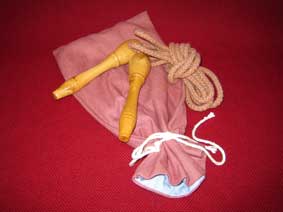
Spinning Toys
| The earliest tops may have originated in Japan. Clay tops have been found at Ur in levels dating from the fourth millenium BC. The Greeks had tops in 579 BC and the Romans in 27BC. They are a wordlwide toy of all periods.They are illustrated in European manuscripts from as early as the 13th century. Whips in the 14th - 16th century are often depicted with three or two ends, knotted as in a scourge. It is thought that they this made the top a popular toy during Lent. It is documented that adults played with tops in the 16th century. |
Windmills
The windmill was a popular toy in the middle ages. It is sometimes depicted with two and sometimes with four sails. Unlike the modern versions available today, it was fixed onto the end of a fairly long stick and children are shown running with the mill held in front of them or riding on a hobby horse with the lance held in front:
Our windmills are painted on both sides for the pleasure of the holder and the watcher. They are secured with a long pin which we recommend you glue in place. |
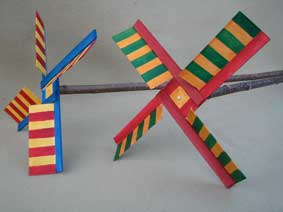 |
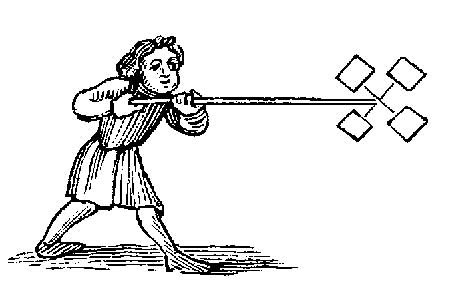 |
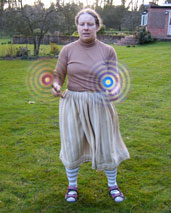 |
Yo-yo
| The yo-yo originated in China. In 1789 the game was known as "Quiz". They were very popular in 19th century France where it was known as Bandalore. The name "Yo-yo" seems to belong to the 20th century. |
| Shell boxes: 7 large; 3 medium scallop-shape and 3 small white ones left £4.50 each |
